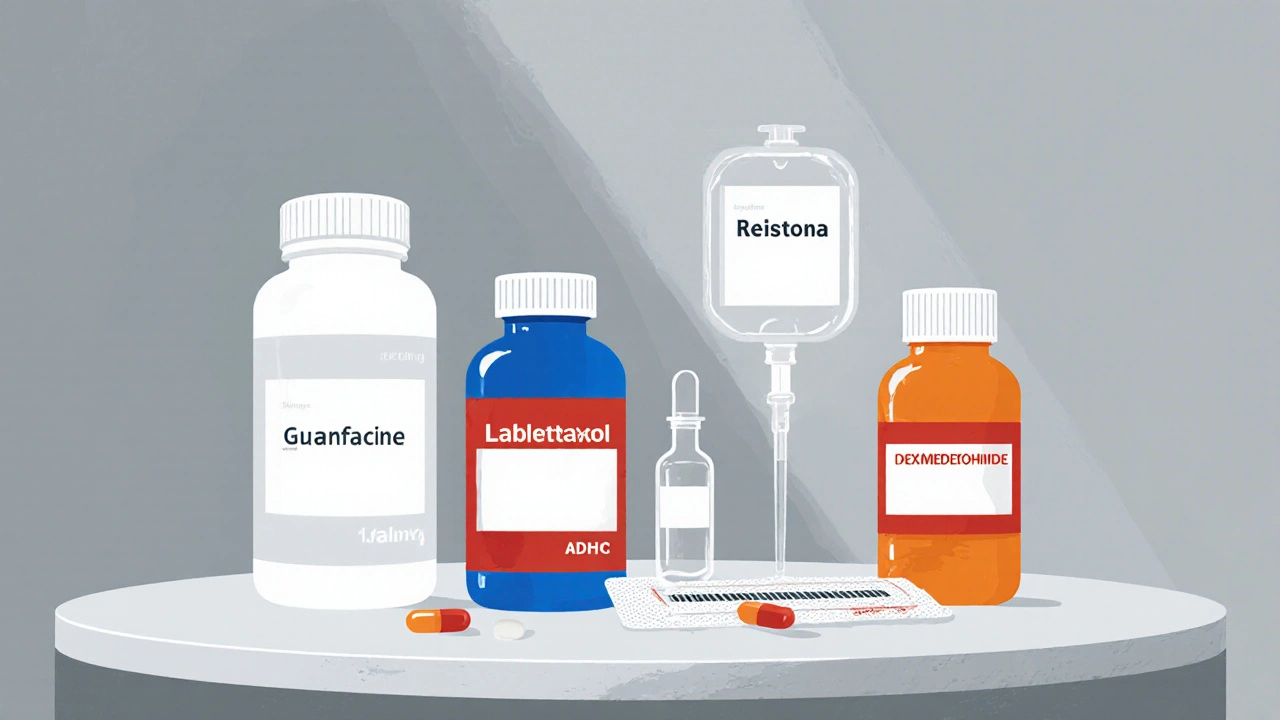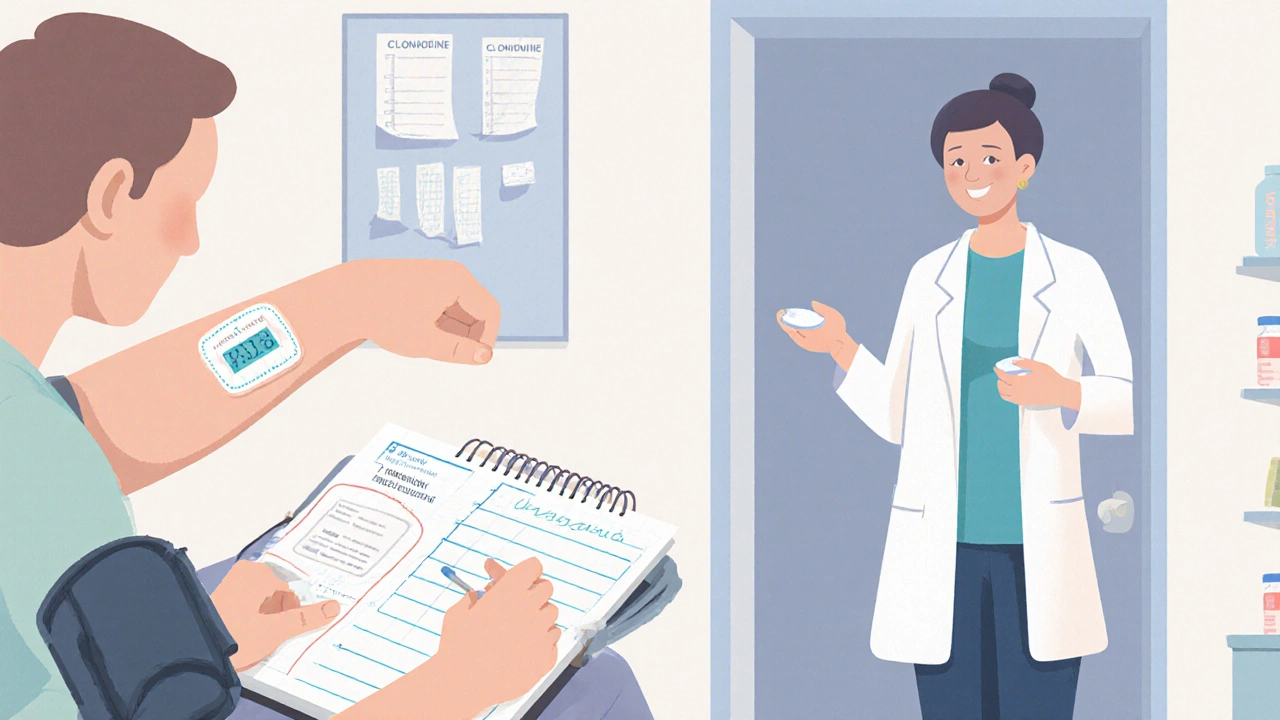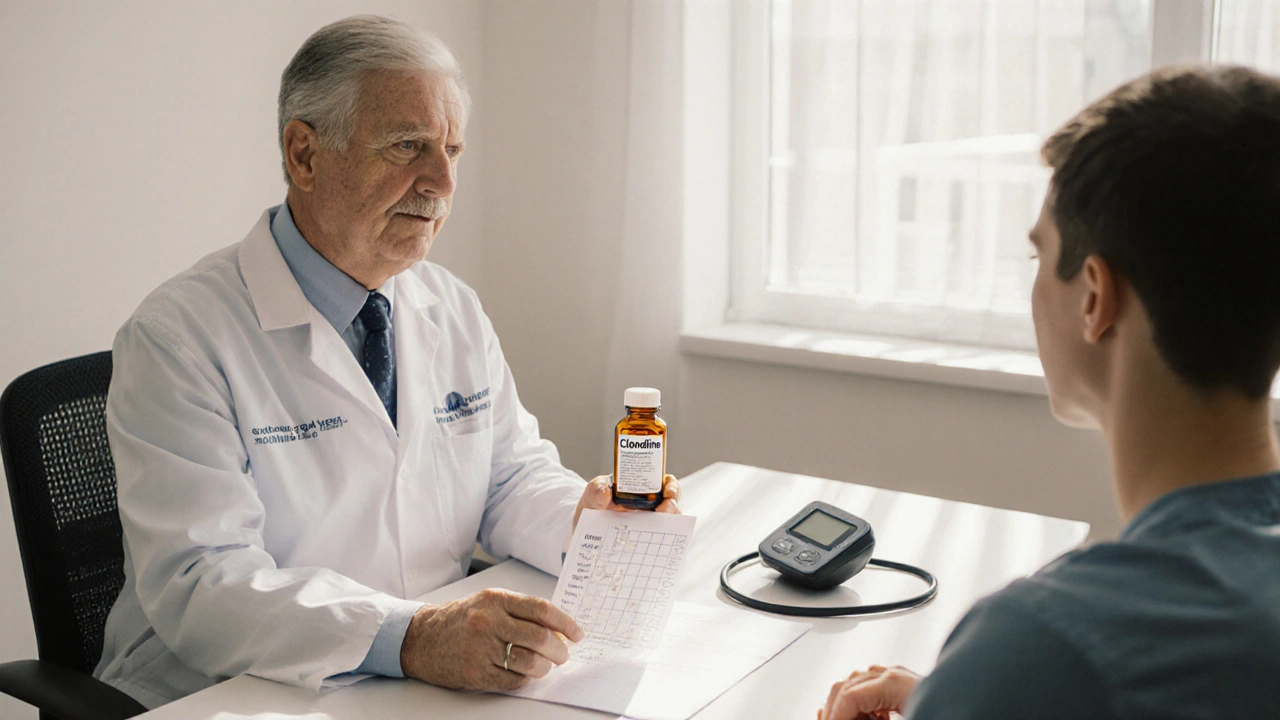Clonidine vs Alternatives: Drug Selector Tool
Drug Comparison Table
| Drug | Primary Mechanism | Typical Indication | Common Dose Range | Half-life | Frequent Side Effects |
|---|---|---|---|---|---|
| Clonidine | Alpha-2 agonist | Hypertension, ADHD | 0.1–0.3 mg BID (oral) | 12–16 h | Dry mouth, sedation, rebound HTN |
| Guanfacine | Alpha-2 agonist | ADHD (children) | 0.5–4 mg daily | 17 h | Drowsiness, hypotension, constipation |
| Methyldopa | Central alpha-2 stimulant (false transmitter) | Chronic hypertension | 250–1000 mg 2–3 ×/day | 2–3 h | Dry mouth, liver enzyme elevation, lupus-like syndrome |
| Labetalol | Beta-blocker + weak alpha-blocker | Hypertensive emergency, pregnancy-related HTN | 100 mg IV bolus, then 20–80 mg/hr infusion | 5–8 h | Bradycardia, bronchospasm, flushing |
| Dexmedetomidine | Highly selective alpha-2 agonist | ICU sedation | 0.2–0.7 µg/kg/hr IV | 2–3 h | Hypotension, bradycardia, dry mouth |
| Clonidine Patch | Alpha-2 agonist (transdermal) | Hypertension, ADHD (adherence aid) | 0.1–0.3 mg/24 h patch, replaced weekly | Continuous release, equivalent to oral | Skin irritation, dry mouth, sedation |
When doctors need to lower blood pressure or manage ADHD symptoms, Clonidine often pops up as an option. But is it always the right pick? This guide walks you through how clonidine works, lines it up against the most common alternatives, and highlights the factors that decide which drug fits a patient best.
Quick Takeaways
- Clonidine is an alpha‑2 adrenergic agonist that lowers blood pressure by reducing central sympathetic output.
- Guanfacine shares the same mechanism but is generally better tolerated for ADHD.
- Methyldopa is an older antihypertensive with a safe profile in pregnancy but higher sedation risk.
- Labetalol combines alpha‑ and beta‑blockade, offering rapid control for hypertensive emergencies.
- Dexmedetomidine is a potent alpha‑2 agonist used in intensive‑care sedation, not chronic therapy.
How Clonidine Works
Clonidine is a centrally acting alpha‑2 adrenergic agonist that decreases norepinephrine release from the brainstem. The result is a drop in peripheral vascular resistance and heart‑rate slowing, which together lower arterial pressure. Because it also dampens sympathetic tone, clonidine can relieve hyperactivity and inattentiveness in ADHD patients.
Key pharmacologic attributes:
- Typical oral dose: 0.1-0.3mg twice daily for hypertension; 0.1mg nightly for ADHD.
- Onset of action: 30‑60minutes (oral), 2‑4hours (transdermal patch).
- Half‑life: 12‑16hours, allowing twice‑daily dosing.
- Common side effects: dry mouth, drowsiness, rebound hypertension if abruptly stopped.

Major Alternatives and When They Shine
Below are the drugs most frequently considered when clonidine isn’t the ideal match. Each alternative is introduced with its own microdata block so search engines can surface the entity clearly.
Guanfacine is another alpha‑2 agonist, marketed mainly for ADHD (brand: Intuniv) and sometimes for hypertension. It tends to cause less sedation than clonidine, making it a favorite for school‑aged children.
Methyldopa works by being converted to alpha‑methylnorepinephrine, a false neurotransmitter that stimulates central alpha‑2 receptors. It’s one of the few antihypertensives deemed safe in pregnancy, though it can cause a lingering dry mouth and mood changes.
Labetalol combines beta‑blockade with weak alpha‑blockade. It’s a go‑to for hypertensive emergencies, especially in pregnant patients, because it rapidly lowers pressure without compromising uterine blood flow.
Dexmedetomidine is a highly selective alpha‑2 agonist used intravenously for ICU sedation. It’s not prescribed for chronic hypertension but illustrates how potency and route affect clinical use.
Clonidine transdermal patch delivers the same molecule through the skin over 7days, improving adherence for patients who struggle with daily pills.
Side‑by‑Side Comparison
| Drug | Primary Mechanism | Typical Indication | Common Dose Range | Half‑life | Frequent Side Effects |
|---|---|---|---|---|---|
| Clonidine | Alpha‑2 agonist | Hypertension, ADHD | 0.1-0.3mg BID (oral) | 12‑16h | Dry mouth, sedation, rebound HTN |
| Guanfacine | Alpha‑2 agonist | ADHD (children) | 0.5-4mg daily | 17h | Drowsiness, hypotension, constipation |
| Methyldopa | Central alpha‑2 stimulant (false transmitter) | Chronic hypertension | 250-1000mg 2‑3×/day | 2‑3h | Dry mouth, liver enzyme elevation, lupus‑like syndrome |
| Labetalol | Beta‑blocker + weak alpha‑blocker | Hypertensive emergency, pregnancy‑related HTN | 100mg IV bolus, then 20‑80mg/hr infusion | 5‑8h | Bradycardia, bronchospasm, flushing |
| Dexmedetomidine | Highly selective alpha‑2 agonist | ICU sedation | 0.2‑0.7µg/kg/hr IV | 2‑3h | Hypotension, bradycardia, dry mouth |
| Clonidine patch | Alpha‑2 agonist (transdermal) | Hypertension, ADHD (adherence aid) | 0.1‑0.3mg/24h patch, replaced weekly | Continuous release, equivalent to oral | Skin irritation, dry mouth, sedation |
Choosing the Right Drug: Decision Factors
Not every patient needs the same pill. Below is a quick decision matrix you can run through in a clinic or at home.
- Indication focus: If the primary goal is ADHD control with minimal day‑time drowsiness, guanfacine usually beats clonidine.
- Pregnancy status: Methyldopa and labetalol are the safest choices; clonidine is classified as Category C.
- Adherence concerns: The weekly patch eliminates missed doses, a common problem in elderly patients.
- Side‑effect tolerance: Patients prone to dry mouth might prefer labetalol, while those with asthma avoid beta‑blockers.
- Cost and availability: Generic clonidine and methyldopa are cheap; dexmedetomidine is hospital‑only and pricey.

Practical Prescribing Tips
- Start clonidine at the low end (0.1mg) and titrate slowly to avoid excessive hypotension.
- Never stop clonidine abruptly; taper over 1‑2weeks to prevent rebound hypertension.
- When switching to guanfacine, overlap for 2‑3days to maintain alpha‑2 coverage.
- Monitor liver enzymes every 3‑6months on methyldopa, especially if the patient has autoimmune tendencies.
- For ICU sedation, dexmedetomidine should be paired with analgesics; it does not provide pain relief.
Frequently Asked Questions
Can clonidine be used long‑term for blood pressure?
Yes, many patients stay on low‑dose oral clonidine for years, but they need regular blood‑pressure checks and a plan to taper if the drug is ever discontinued.
Is the clonidine patch more effective than pills?
Effectiveness is comparable; the advantage lies in steady drug levels and better adherence, especially for patients who miss daily doses.
What makes guanfacine better for ADHD than clonidine?
Guanfacine has a longer half‑life and less sedation, so children can stay alert in school while still getting the calming effect on hyperactivity.
Are there any serious drug interactions with clonidine?
Combining clonidine with other antihypertensives (especially beta‑blockers) can cause excessive hypotension. It also enhances the sedative effects of CNS depressants like benzodiazepines and alcohol.
Which alternative is safest during pregnancy?
Methyldopa and labetalol have the longest track record of safety in pregnancy. Clonidine is only used if benefits outweigh potential risks.
Next Steps for Clinicians and Patients
If you’re a prescriber, start by matching the patient’s main problem (high blood pressure vs ADHD) to the drug class that targets it most directly. Use the comparison table to spot dose ranges and side‑effect profiles, then discuss adherence options (patch vs tablet) during the appointment.
Patients should keep a simple log of blood‑pressure readings, any drowsiness, and how often they miss doses. Bring that log to the next visit - it’s the fastest way to decide whether to stay on clonidine, switch to guanfacine, or try a completely different class.
Finally, always schedule a follow‑up within 2‑4weeks after any change. Small dose tweaks can swing blood pressure dramatically, and early detection of side effects prevents long‑term problems.

Mansi Mehra
Clonidine’s oral regimen typically begins at 0.1 mg twice daily, with titration up to 0.3 mg twice daily as tolerated; clinicians should verify blood‑pressure response before increasing the dose.
Danielle Spence
Prescribing clonidine without a clear taper plan is medically negligent; patients deserve a structured discontinuation schedule to avoid rebound hypertension. When a clinician opts for an alpha‑2 agonist, they must also counsel on the risk of excessive sedation, especially in the elderly. Ignoring these safeguards perpetuates a cycle of iatrogenic harm that the profession should not tolerate.
Dhanu Sharma
Guanfacine works similarly but lasts longer its half‑life is about 17 hours making once‑daily dosing possible it also has less sedation than clonidine which is useful for school kids.
Edward Webb
From a physiological viewpoint, reducing central sympathetic outflow addresses both hypertension and the hyperactivity seen in ADHD, yet the choice of agent must reflect the patient’s lifestyle; a patch may suit someone with adherence challenges, whereas an oral tablet offers flexibility for dose adjustments. The clinician’s role is to balance efficacy with quality of life, recognizing that a lower heart rate may be as valuable as a lower systolic pressure for the individual’s sense of well‑being.
Snehal Suhane
Oh sure, because nothing says “I care” like slapping a 0.2 mg clonidine patch on a teenager who can’t remember to change it weekly. It’s not like you could just prescribe guanfacine, which is actually designed for kids, right? Guess we love the “one‑size‑fits‑all” approach of pharma-makes sense.
Ernie Rogers
Clonidine isn’t the first pick for pregnant hypertension.
Eunice Suess
Listen, the side‑effects aren’t just “dry mouth”; you’ll get a constant, nagging thirst that feels like you’re in a desert-seriously, patients report waking up at 3 am just to chug water.
Anoop Choradia
It must be noted that the extensive marketing of clonidine as a universal agent masks the underlying agenda of pharmaceutical conglomerates seeking to dominate both the antihypertensive and neurobehavioral markets, thereby limiting physicians’ exposure to less profitable, yet clinically superior, alternatives.
bhavani pitta
While many clinicians champion guanfacine for pediatric ADHD, the evidence supporting its superior safety profile over clonidine remains inconclusive; a thorough review of the randomized trials reveals comparable sedation rates, suggesting that the prevailing preference may be driven more by commercial bias than by robust data.
Brenda Taylor
Honestly, if you’re prescribing clonidine without discussing the rebound hypertension risk, you’re doing a disservice to your patients 😊 they deserve transparent info about every possible downside.
virginia sancho
For patients worried about the weekly patch, advise them to set a reminder on their phone; the patch delivers steady plasma levels and eliminates the peaks and troughs that often cause daily dosing headaches.
Namit Kumar
Just a heads‑up: combining clonidine with other antihypertensives can drop blood pressure too low 😬 monitor vitals closely after any dose changes.
Sam Rail
Overall, clonidine works well when used carefully, but always keep an eye on those side effects.
Taryn Thompson
In accordance with current clinical guidelines, clonidine should be initiated at the lowest effective dose and titrated cautiously, ensuring that patients are educated about potential adverse events. But hey, if you’re already on it and feeling fine, no need to panic.
Lisa Lower
When you look at the pharmacodynamics of clonidine, you see a clear reduction in central sympathetic tone, which translates into lower peripheral resistance and a modest heart‑rate decrease; this mechanism is shared with guanfacine but differs in receptor selectivity, giving clonidine a slightly broader effect profile. The practical upshot is that clonidine can be leveraged for both hypertension and ADHD, making it a versatile tool in the clinician’s arsenal. However, versatility comes with trade‑offs; the drug’s side‑effect constellation-dry mouth, sedation, and the notorious rebound hypertension-requires diligent patient education. Starting doses are deliberately low, typically 0.1 mg twice daily, to gauge tolerance before any escalation. In many cases, patients report an improvement in nocturnal blood pressure readings within one week, an encouraging sign for adherence. Yet, the sedative quality may interfere with daytime activities, especially in younger adults who need to stay alert for work or school. For those patients, a switch to guanfacine, with its longer half‑life and reduced drowsiness, might be more appropriate. The transdermal patch offers an alternative delivery method, delivering a steady dose over seven days and sidestepping the pill burden; still, skin irritation can be a limiting factor. Monitoring liver enzymes is not routinely required for clonidine, unlike methyldopa, which can induce hepatic changes and even lupus‑like syndromes. Cost considerations also favor clonidine, as generic versions are widely available and inexpensive compared to newer agents. From a safety standpoint, abrupt discontinuation is a red flag; tapering over one to two weeks mitigates the risk of rebound spikes that could endanger patients with previously controlled hypertension. Clinicians should also be wary of pharmacodynamic interactions, particularly with other central depressants such as benzodiazepines, which can amplify sedation. In the ICU setting, the more potent dexmedetomidine is preferred for sedation, underscoring that clonidine’s potency is suitable for outpatient use rather than critical care. Patient preference plays a pivotal role; some individuals favor the simplicity of a weekly patch, while others dislike the adhesive and opt for oral tablets. Ultimately, individualized therapy-balancing efficacy, side‑effect profile, cost, and patient lifestyle-determines whether clonidine remains the optimal choice.
Dana Sellers
People need to stop treating drugs like toys; you can't just hop on clonidine and ignore the side‑effects, that's reckless.
Damon Farnham
Indeed, the casual attitude toward prescription medications is alarming; it breeds dependency, it undermines informed consent, and it perpetuates a culture of negligence.
Gary Tynes
Great breakdown! If you’re trying this at home, set daily checkpoints for blood pressure and mood, and keep a journal – it really helps spot patterns early.